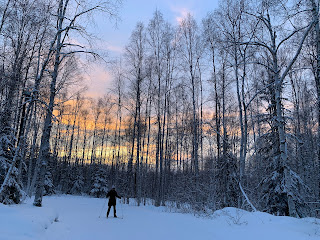It happened all of a sudden and it was amazing. I didn't get to post my other half-written blog posts, but I'll do that later on.
The science event was ideal - in fact, it was one of the best pulsating aurora events I've ever seen on camera data. Lots of large patches blinking on and off across the sky at three different field sites: Poker (where the majority of the science team was), Fort Yukon, and Venetie. Venetie was the site under the rocket apogee so they were most critical to our launch call. We were on the satellite phone with them and they claimed great pulsating aurora overhead (with faster internal modulations that we were looking for, which likely indicate a phenomenon called microbursts). But we didn't see the camera data showing that since it uploads through an Iridium GO connection and was about 4 minutes behind in time. We dropped the count anyway and as the timer fell, we kept asking: Do you still see the modulations? The answer was yes each time - this was it, the event we were hoping for. When the website finally refreshed to show us what they were looking at, we all cheered. It was indeed a fantastic event, with the fast-blinking pulsating aurora right overhead.
As the countdown continued we hoped it would last... After T minus zero, the rocket still has about 7 minutes to fly before it gets overhead Venetie. Turns out, the pulsating aurora lasted for over an hour so we had nothing to worry about.
 |
| Beautiful shot by our documentary film crew |
As the clock ran down to T minus 1:30, we all raced down the hall and out the second-story door to the catwalk, where you have a direct view of the launchpad down the hill. What a sight to see our rocket fly true, directly through patches of pulsating aurora overhead.
There were a lot of happy faces that night. I'm glad the doc crew was there to capture it all. Did I mention there was a documentary being filmed for NHK? It might be all in Japanese, except the interviews with us Americans, but they filmed all aspects of the launch and the nights leading up to it. I'll have a link eventually.
I was carrying my PhD advisor, Marc, around on the laptop through the chaos leading up to launch - showing him the data and being very excited about what was developing.
 |
| Showing Marc the internal modulations Venetie was seeing - notice the clock at T minus 5:37!! |
 |
| Mike noticed how sublimely happy I look in this picture, even through the mask. Check out the allsky camera display in the background - amazing pulsating aurora everywhere! |
We were all so incredibly happy with the result. Sometimes with launches there is trepidation even after the fact: did we hit the right event? Will the data show something useful? This time there were no doubts. It was unambiguously the best case scenario.
 |
| Three awesome lady Co-I's and thumbs up from Marc. |
 |
| The whole team! Very pleased with ourselves. |
The unexpected element of all this was the NHK film crew. I will miss them. They brought fun and novelty to the launch experience and filmed the most amazing footage (some of which will be released to us soon and then I can share). They were all passionate about science and astrophotography and incredibly good at their jobs. Thank you, Reina, Michael, and Justin!!
 |
| "L" for LAMP! |


















